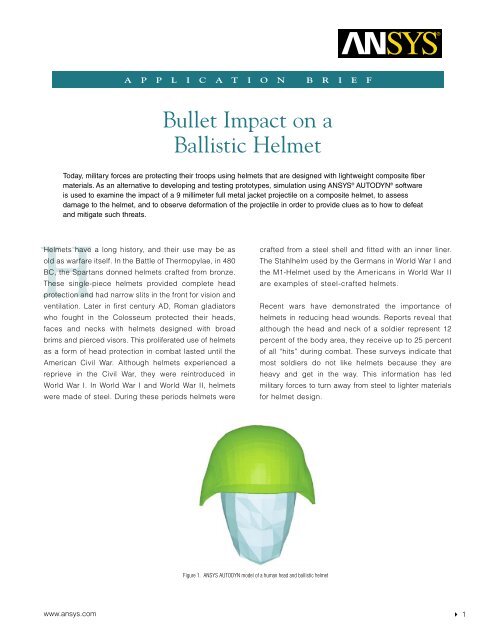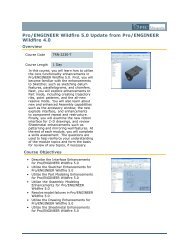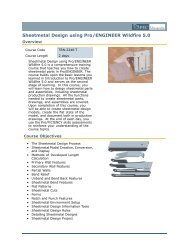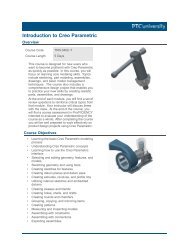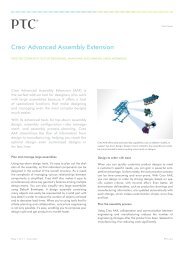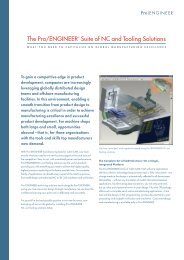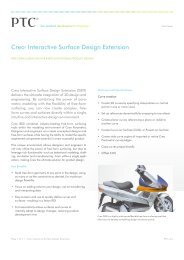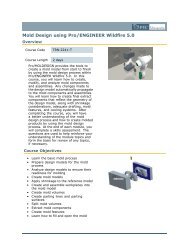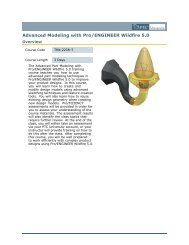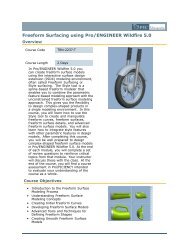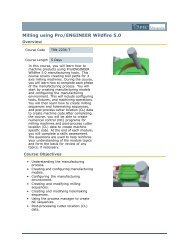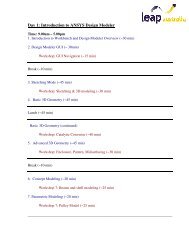Bullet Impact on a Ballistic Helmet
Bullet Impact on a Ballistic Helmet
Bullet Impact on a Ballistic Helmet
You also want an ePaper? Increase the reach of your titles
YUMPU automatically turns print PDFs into web optimized ePapers that Google loves.
A P P L I C A T I O N B R I E F<br />
<str<strong>on</strong>g>Bullet</str<strong>on</strong>g> <str<strong>on</strong>g>Impact</str<strong>on</strong>g> <strong>on</strong> a<br />
<strong>Ballistic</strong> <strong>Helmet</strong><br />
Today, military forces are protecting their troops using helmets that are designed with lightweight composite fiber<br />
materials. As an alternative to developing and testing prototypes, simulati<strong>on</strong> using ANSYS ® AUTODYN ® software<br />
is used to examine the impact of a 9 millimeter full metal jacket projectile <strong>on</strong> a composite helmet, to assess<br />
damage to the helmet, and to observe deformati<strong>on</strong> of the projectile in order to provide clues as to how to defeat<br />
and mitigate such threats.<br />
<strong>Helmet</strong>s have a l<strong>on</strong>g history, and their use may be as<br />
old as warfare itself. In the Battle of Thermopylae, in 480<br />
BC, the Spartans d<strong>on</strong>ned helmets crafted from br<strong>on</strong>ze.<br />
These single-piece helmets provided complete head<br />
protecti<strong>on</strong> and had narrow slits in the fr<strong>on</strong>t for visi<strong>on</strong> and<br />
ventilati<strong>on</strong>. Later in first century AD, Roman gladiators<br />
who fought in the Colosseum protected their heads,<br />
faces and necks with helmets designed with broad<br />
brims and pierced visors. This proliferated use of helmets<br />
as a form of head protecti<strong>on</strong> in combat lasted until the<br />
American Civil War. Although helmets experienced a<br />
reprieve in the Civil War, they were reintroduced in<br />
World War I. In World War I and World War II, helmets<br />
were made of steel. During these periods helmets were<br />
crafted from a steel shell and fitted with an inner liner.<br />
The Stahlhelm used by the Germans in World War I and<br />
the M1-<strong>Helmet</strong> used by the Americans in World War II<br />
are examples of steel-crafted helmets.<br />
Recent wars have dem<strong>on</strong>strated the importance of<br />
helmets in reducing head wounds. Reports reveal that<br />
although the head and neck of a soldier represent 12<br />
percent of the body area, they receive up to 25 percent<br />
of all “hits” during combat. These surveys indicate that<br />
most soldiers do not like helmets because they are<br />
heavy and get in the way. This informati<strong>on</strong> has led<br />
military forces to turn away from steel to lighter materials<br />
for helmet design.<br />
Figure 1. ANSYS AUTODYN model of a human head and ballistic helmet<br />
www.ansys.com<br />
1
Figure 2. Projectile impact, showing the deformati<strong>on</strong> of both the outer surface of the helmet and the projectile itself<br />
Today, military forces are protecting their troops with<br />
helmets designed using lightweight composite fiber<br />
materials. The PASGT (United States), MICH (United<br />
States), MK-6 (United Kingdom) and SPECTRA<br />
(Denmark) helmets are examples of designs that use<br />
lightweight fiber materials. The <strong>on</strong>going development<br />
of lighter and str<strong>on</strong>ger fiber materials — para-aramid<br />
(KEVLAR ® , Twar<strong>on</strong> ® ), UHMW polyethylene (Spectra ® ,<br />
Dyneema ® ) and PBO (Zyl<strong>on</strong> ® ) — has persuaded defense<br />
agencies to agree that the next generati<strong>on</strong> of combat<br />
helmets should be lightweight and yet provide superior<br />
protecti<strong>on</strong>.<br />
In the development of the next generati<strong>on</strong> of combat<br />
helmets, research agencies and defense c<strong>on</strong>tractors<br />
subject prototype helmets to a series of ballistic tests to<br />
ensure that these new designs provide adequate<br />
protecti<strong>on</strong>. The ballistic tests involve accelerating a<br />
projectile against a helmet and determining whether<br />
the helmet is able to defeat the incoming projectile.<br />
The process of creating a prototype helmet and striking<br />
it with a projectile can be expensive when exploring<br />
fiber materials and design variati<strong>on</strong>s. Hydrocode<br />
simulati<strong>on</strong>s can reduce the cost of development.<br />
By creating helmet simulati<strong>on</strong> models, engineers<br />
perform virtual scenario analyses. In these scenario<br />
analyses, engineers subject the helmet models to various<br />
threats and then analyze their resp<strong>on</strong>ses and vulnerability<br />
to these threats. The results from these analyses<br />
allow the engineers to make informed decisi<strong>on</strong>s <strong>on</strong> the<br />
approach and to strategize to mitigate these threats.<br />
This article dem<strong>on</strong>strates the resp<strong>on</strong>se of a ballistic<br />
helmet to a probable threat — an accelerating 9<br />
millimeter full metal jacket (FMJ). The 9 millimeter FMJ,<br />
which weighs approximately 8 grams, is the quintessential<br />
ammuniti<strong>on</strong> for handguns and pistols. The<br />
simulated projectile, which c<strong>on</strong>sists of a brass jacket<br />
encapsulating a lead core, strikes the side of the<br />
simulated composite helmet model at 358 meters per<br />
sec<strong>on</strong>d. The simulati<strong>on</strong> is carried out using ANSYS<br />
AUTODYN software, a commercial hydrocode.<br />
A hydrocode is a computer program that is capable of<br />
computing strains, stresses, velocities and propagati<strong>on</strong><br />
of shock waves as a functi<strong>on</strong> of space and time. In the<br />
last three decades, hydrocodes have been used<br />
extensively to simulate the penetrati<strong>on</strong> and perforati<strong>on</strong><br />
© 2008 ANSYS, Inc. All Rights Reserved.<br />
2
of isotropic materials (i.e., steel and aluminum) when<br />
subjected to high velocity and hypervelocity impacts.<br />
With the development of lighter and str<strong>on</strong>ger fiber materials<br />
(i.e., KEVLAR ® , Twar<strong>on</strong> ® , Spectra ® and Dyneema ® ), the<br />
scientific community expresses a growing interest in the use<br />
of hydrocode to study ballistic impact of anisotropic<br />
materials in the development of composite armor.<br />
Unlike the ballistic resp<strong>on</strong>se of isotropic materials such<br />
as steel or aluminum, the ballistic resp<strong>on</strong>se of anisotropic<br />
material is more complex and requires extensive<br />
material characterizati<strong>on</strong>.<br />
In a project with the European Space Agency (ESA), the<br />
developers of ANSYS AUTODYN implemented a<br />
composite material model that could couple anisotropic<br />
c<strong>on</strong>stituent behavior with n<strong>on</strong>linear shock resp<strong>on</strong>se.<br />
The composite material model in ANSYS AUTODYN<br />
takes into account the following complex phenomena<br />
related to high velocity and hypervelocity of anisotropic<br />
materials: anisotropic strength degradati<strong>on</strong>; material<br />
anisotropy; melting, vaporizati<strong>on</strong> and decompositi<strong>on</strong>;<br />
shock resp<strong>on</strong>se; and coupling of volumetric and<br />
deviatoric resp<strong>on</strong>se.<br />
The simulati<strong>on</strong> results for the helmet reveal that though<br />
the projectile does not perforate the helmet, it possesses<br />
sufficient momentum and kinetic energy to deform<br />
the wall of the helmet. Figure 2 shows the helmet before,<br />
during, and after impact. The transient results from the<br />
simulati<strong>on</strong>, depicted in Figure 3, reveal that the impact<br />
regi<strong>on</strong>, both <strong>on</strong> the outside and inside of the helmet,<br />
deforms with a high velocity. This high velocity al<strong>on</strong>g the<br />
thickness of the helmet can cause delaminati<strong>on</strong>.<br />
The delaminati<strong>on</strong> of the composite layers often results in<br />
a backplane signature which may exceed the optimal<br />
standoff (i.e., the distance separating the head and the<br />
inner surface of the helmet), causing impact to the head<br />
al<strong>on</strong>g with brain trauma. Figure 4 shows the deformati<strong>on</strong><br />
that occurs <strong>on</strong> the inner surface of the helmet as the<br />
projectile impacts the outer surface. Such instances<br />
explain how a helmet may defeat an incoming projectile,<br />
and yet the soldier d<strong>on</strong>ning the helmet may experience<br />
brain injury. The simulati<strong>on</strong> results indicate failure in the<br />
fibers at the impact regi<strong>on</strong> and the inside the helmet.<br />
Fortunately, the deformati<strong>on</strong> and the fiber failure are not<br />
substantial enough to compromise the optimal standoff and<br />
the safety of the soldier using the helmet in this scenario.<br />
Figure 3. Velocity c<strong>on</strong>tours for the helmet body as impact from the projectile occurs<br />
www.ansys.com<br />
3
Figure 4. Deformati<strong>on</strong> of the inner surface of the helmet as the projectile impacts the outer surface<br />
The simulati<strong>on</strong> also predicts the deformati<strong>on</strong> of the 9<br />
millimeter FMJ (seen in Figure 2). Accurate predicti<strong>on</strong><br />
of the deformati<strong>on</strong> of the projectile can provide clues<br />
and answers to engineers seeking to defeat and mitigate<br />
such threat. In this scenario, the 9 millimeter<br />
FMJ suffers severe deformati<strong>on</strong> <strong>on</strong> impact and later<br />
collapses, which reduces its effectiveness in perforating<br />
and penetrating the helmet.<br />
In c<strong>on</strong>clusi<strong>on</strong>, this article has dem<strong>on</strong>strated the<br />
applicati<strong>on</strong> of the composite material model in ANSYS<br />
AUTODYN software for predicting the ballistic<br />
resp<strong>on</strong>se of a composite helmet. This technology is<br />
now available for ballisticians seeking to develop composite<br />
helmet and armor for future combat systems.<br />
Hence, the dem<strong>on</strong>strati<strong>on</strong> should inspire and motivate<br />
engineers to complement ballistic tests with hydrocode<br />
simulati<strong>on</strong> in order to reduce the cost of developing<br />
the next generati<strong>on</strong> of combat helmets.<br />
About ANSYS, Inc.<br />
ANSYS, Inc., founded in 1970, develops and globally markets engineering<br />
simulati<strong>on</strong> software and technologies widely used by engineers and designers<br />
across a broad spectrum of industries. ANSYS focuses <strong>on</strong> the development of<br />
open and flexible soluti<strong>on</strong>s that enable users to analyze designs directly <strong>on</strong> the<br />
desktop, providing a com<strong>on</strong> platform for fast, efficient and cost-c<strong>on</strong>scious<br />
product development, from design c<strong>on</strong>cept to final-stage testing and<br />
validati<strong>on</strong>. ANSYS and its global network of channel partners provide sales,<br />
support and training for customers. Headquartered in Can<strong>on</strong>sburg,<br />
Pennsylvania, U.S.A., with more than 60 strategic sales locati<strong>on</strong>s throughout<br />
the world, ANSYS and its subsidiaries employ approximately 1,700 people and<br />
distribute ANSYS products through a network of channel partners in over<br />
40 countries. Visit http://www.ansys.com for more informati<strong>on</strong>.<br />
ANSYS, Inc.<br />
Southpointe<br />
275 Technology Drive<br />
Can<strong>on</strong>sburg, PA 15317<br />
U.S.A.<br />
724.746.3304<br />
ansysinfo@ansys.com<br />
www.ansys.com<br />
Toll Free U.S.A./Canada:<br />
1.866.267.9724<br />
Toll Free Mexico:<br />
001.866.267.9724<br />
Europe:<br />
44.870.010.4456<br />
eu.sales@ansys.com<br />
www.ansys.com<br />
4


